Meteo: Part Two
By Gorilla Doctors Staff on Tuesday, April 6th, 2010 in Uncategorized.Meteo is a strong little gorilla. Dr. Jacques returned to Kahuzi Biegi a couple of days after we left him last week, and Meteo continued to do very well. He was eating and behaving normally. His elbow does not fully extend, but that does not seem to bother him. Amazing. Dr. Jacques reported that Meteo’s hand was still hanging by a thread, and was beginning to smell. Now we were really worried about infection.
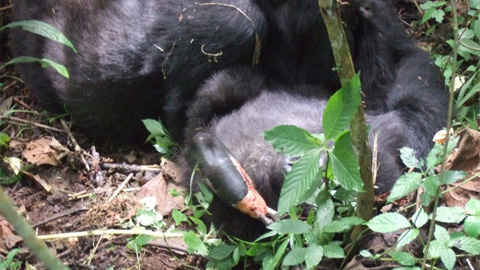 Meteo resting, showing the exposed ulna and radius. The skin was healing well but there was so much exposed tissue.
Meteo resting, showing the exposed ulna and radius. The skin was healing well but there was so much exposed tissue.
This time Dr. Eddy and I drove the 7 hours through Rwanda and crossed the border into DRC at Bukavu. We drove through Nyungwe National Park in Rwanda – a huge park known for its many primate species including chimps, and the largest Colobus monkey troop in Africa (reportedly 400 monkeys!). It was a lovely, curvy 2 hour drive through the forested mountains, and while we didn’t see chimps or Colobus monkeys we did see some L’Hoest’s guenons playing in the bushes near the road!
Dr. Jacques, Dr. Eddy and I stayed at a little hotel on Lake Kivu that night. As we ate dinner we watched the fishing boats head out onto the lake and went over our plan for the next day. Again, in an ideal world we would amputate, but we did not know how Chimanuka would react to us after last week. We did not know if Meteo would stay out of the trees long enough for us to get a shot. At the very least we would try to inject him with antibiotics via a flying dart. We knew we could take a bit more risk with an antibiotic dart than an anesthetic dart, but we still had to have something other than tree branches to aim at!
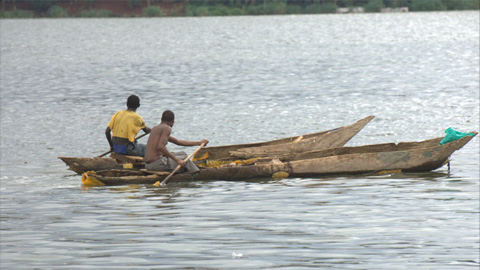 Fishermen headed out for the evening.
Fishermen headed out for the evening.
The next morning we headed to the forest quite early, hoping to get a good look at Meteo before the gorilla group’s mid-morning rest period. Unfortunately for us, just as we got to the group, the skies let loose and it poured. We all retreated into our raingear and got as close to the trees as we could for the next hour.
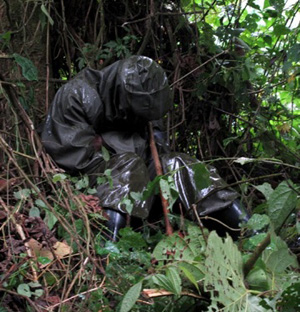 One of the trackers trying to stay dry and warm.
One of the trackers trying to stay dry and warm.
Finally the rain let up, and trackers headed off to find the gorillas again. This time we did not want to alarm Chimanuka, so only 2 trackers headed deeper into the forest to locate the silverback (so we knew just where he was) and to locate Meteo. The rest of us waited patiently for another hour or so. It can take a long time to find individual gorillas in a group of more than 30 in this dense forest!
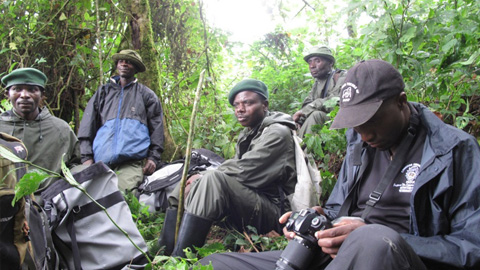 Dr. Eddy (right) and trackers waiting for the advance trackers to find Chimanuka and Meteo.
Dr. Eddy (right) and trackers waiting for the advance trackers to find Chimanuka and Meteo.
When the trackers got back there was good news. Meteo’s hand had fallen off, as had one of the exposed bones. Dr. Jacques, Dr. Eddy and I slowly and quietly approached the group, and found Meteo sitting quite close to Chimanuka. Mugeni was several meters away, looking well. Meteo was licking the stump, keeping it clean. The rotten hand was gone, along with the 3cm of exposed ulna. The stump looked amazingly well, all things considered. And it no longer had a bad odor, another good sign!
We Gorilla Doctors retreated to a point in the forest about 100 meters from the gorillas to consider our options. If we tried to anesthetize, at this point it could be very risky with Chimanuka sitting right next to Meteo. The wound was looking quite good, and the remaining exposed bone was beginning to turn dark indicating that it would likely come off on its own as well. If we could just keep the exposed bones from becoming infected Meteo had a good chance at recovery. We decided to load an antibiotic dart and hope for the best. When we got back to the spot where they had been resting, Chimanuka had moved away, and before I could lower the pistol to take a shot, hiding behind 2 trackers, Meteo moved off after his father. Rats.
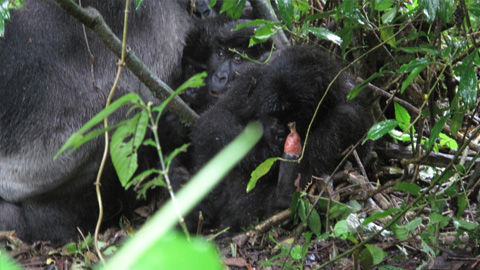 Meteo, with only one bone exposed now, sitting near the back of his father Chimanuka.
Meteo, with only one bone exposed now, sitting near the back of his father Chimanuka.
We followed the group for the next 5 hours, up and down ravines, waited while they slept in the trees, and finally down a very, very steep ravine in an area that looked enchanted! The air was cool and there was a slight breeze. The trees were laden with moss and ferns, and there was a small brook at the bottom of the ravine. Absolutely lovely. We were about halfway down the ravine and could see Chimanuka at the bottom eating contentedly. We even saw him take a long drink of water from the stream, which is somewhat unusual. Gorillas are thought to get their required liquids form the plants they eat – they are very rarely seen drinking water directly. Several gorillas were high in the trees eating and resting. It was a very peaceful scene. Unfortunately Meteo was nowhere to be found. We stayed for another hour, but the head tracker said our chances were slim, even if we stayed until the last light of the day. So at 3pm we packed our bags once again and headed back to the hotel. We would give it one more try tomorrow.
We headed back into the forest early in the morning. There was more rain, more steep ravines and mud, and vegetation so dense that you could not see the person 4 feet in front of you! At one point we heard gorillas screaming (some small fight over food, the trackers told us) and a monkey joined in. Two turacos (a BEAUTIFUL African forest bird) flew over flashing their bright red wing patches. A hornbill also floated by, heavy head and white wings.
But for another 5 hours Meteo eluded us. We got glimpses now and then, but never a good view, and then he was gone. We saw Chimanuka well, and he did not seem concerned about our presence. If only we could find Meteo. We had settled into another waiting period during yet another rain when finally, about noon, the trackers found him. We loaded the dart and Dr. Eddy headed off, dart gun in hand. Dr. Jacques and I stayed back, not wanting to appear to be chasing the young gorilla. This would give Dr. Eddy the best chance at a shot.
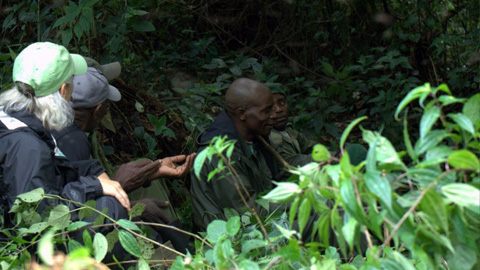 Dr. Jacques, the trackers and I waiting for word from Dr. Eddy.
Dr. Jacques, the trackers and I waiting for word from Dr. Eddy.
About an hour later a smiling Dr. Eddy emerged from the forest. Success at last! Little Meteo had powerful antibiotics on board, and had his best chance at survival under the circumstances. This time we packed our bags feeling a little more optimistic. Once again the trackers would watch carefully each day, and report any changes to us right away. Dr. Eddy and I started on our long drive back to Ruhengeri and Dr. Jacques took the boat. No lightening this time. Just a couple of check points and lots of fog during our 7 hour drive. We made it back to Ruhengeri about midnight, tired but relieved.
That was last week. Yesterday I got a report from Dr. Jacques. The other exposed bone had finally come off, and the tissue at the end of the stump seems to be covering the ends of the bones. Meteo is healing well, and will grow up to be a silverback just like his father Chimanuka. It will be interesting to watch his progress – maybe he’ll stay with his father, helping protect the family he’ll grow up in.
Help the Gorilla Doctors.


 Donate
Donate